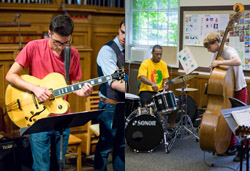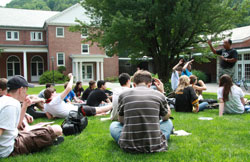Combos:
 Combo Class is for playing and is the most important component of the Litchfield Jazz Camp. Throughout jazz history, the core jazz ensemble (rhythm section and horns) has been the core opportunity for creativity, expression and learning experience via the classic lead-from-the-front/apprenticeship model. This class gives you a taste of that environment with a faculty member as the band leader. The primary goals for the Combo Class are to improve your ability to:
Combo Class is for playing and is the most important component of the Litchfield Jazz Camp. Throughout jazz history, the core jazz ensemble (rhythm section and horns) has been the core opportunity for creativity, expression and learning experience via the classic lead-from-the-front/apprenticeship model. This class gives you a taste of that environment with a faculty member as the band leader. The primary goals for the Combo Class are to improve your ability to:
- Play the melodies of various types of tunes well, both individually and as an ensemble
- Improvise over chord changes maintaining your place in the form
- Hone your general skills in small group performance
- Express yourself within the group context effectively and emotionally
Theory:
Prior to arriving at camp we will send you an online theory assessment to complete. At LJC jazz theory is taught through practical learning. The overall goal of this class is to help you better understand, hear, play and/or sing jazz melody, harmony and rhythm, both improvised and written. While there is a written element, you’ll be encouraged to play and sing everything reinforcing what you’ll be learning. You may already have an understanding of music theory elements like key signatures, scales, chords, cycles, etc., but the spontaneous and real-time nature of jazz improvisation requires that you execute these elements fluently. After all, music theory elements are part of the “alphabet” of the language of jazz.
Master Classes:
 While your combo leader may or may not play your primary instrument, master classes are broken out by instrument and level. For example, if you play piano, you will be in master class with a piano instructor with other piano students at your level. The purpose of the Master Class is to help you learn how to handle performance and technical issues on your instrument or voice especially as applied to jazz playing. Effective and expressive music performance technique starts with a clear musical vision and concept as well as the right mindset. You’ll work on this vision and attitude and then you’ll focus on technical issues (this varies from level to level) which include body positions, proper breathing, sound production, rhythm and time feel, articulation, scale and chord practice, rudiments, and of course warming-up and practicing effectively.
While your combo leader may or may not play your primary instrument, master classes are broken out by instrument and level. For example, if you play piano, you will be in master class with a piano instructor with other piano students at your level. The purpose of the Master Class is to help you learn how to handle performance and technical issues on your instrument or voice especially as applied to jazz playing. Effective and expressive music performance technique starts with a clear musical vision and concept as well as the right mindset. You’ll work on this vision and attitude and then you’ll focus on technical issues (this varies from level to level) which include body positions, proper breathing, sound production, rhythm and time feel, articulation, scale and chord practice, rudiments, and of course warming-up and practicing effectively.
